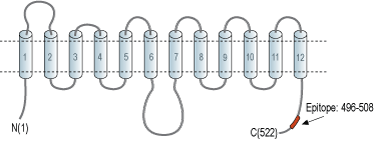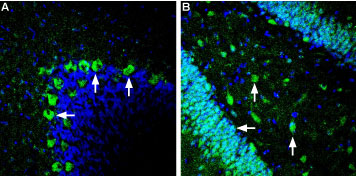Overview
- Peptide (C)EFRKKSGSAPPRK, corresponding to amino acid residues 496-508 of rat Glucose Transporter 2 (Accession P12336). Intracellular, C-terminus.

 Western blot analysis of rat liver membranes:1. Anti-GLUT2 (SLC2A2) Antibody (#AGT-022), (1:400).
Western blot analysis of rat liver membranes:1. Anti-GLUT2 (SLC2A2) Antibody (#AGT-022), (1:400).
2. Anti-GLUT2 (SLC2A2) Antibody, preincubated with GLUT2/SLC2A2 Blocking Peptide (#BLP-GT022). Western blot analysis of mouse brain membranes:1. Anti-GLUT2 (SLC2A2) Antibody (#AGT-022), (1:200).
Western blot analysis of mouse brain membranes:1. Anti-GLUT2 (SLC2A2) Antibody (#AGT-022), (1:200).
2. Anti-GLUT2 (SLC2A2) Antibody, preincubated with GLUT2/SLC2A2 Blocking Peptide (#BLP-GT022). Western blot analysis of human Caco-2 colorectal adenocarcinoma cell line lysate (lanes 1 and 3) and human HepG2 liver hepatocellular carcinoma cell lysate (lanes 2 and 4):1-2. Anti-GLUT2 (SLC2A2) Antibody (#AGT-022), (1:400).
Western blot analysis of human Caco-2 colorectal adenocarcinoma cell line lysate (lanes 1 and 3) and human HepG2 liver hepatocellular carcinoma cell lysate (lanes 2 and 4):1-2. Anti-GLUT2 (SLC2A2) Antibody (#AGT-022), (1:400).
3-4. Anti-GLUT2 (SLC2A2) Antibody, preincubated with GLUT2/SLC2A2 Blocking Peptide (#BLP-GT022).
 Expression of Glucose Transporter 2 in rat cerebellum and hippocampusImmunohistochemical staining of perfusion-fixed frozen rat brain sections using Anti-GLUT2 (SLC2A2) Antibody (#AGT-022), (1:120), followed by goat-anti-rabbit-AlexaFluor-488 (green). Cell nuclei are stained with DAPI (blue). A. Staining in cerebellum sections, reveals GLUT2 labeling in Purkinje cells (arrows). B. Staining in hippocampus dentate gyrus, shows labeling of both granule cells (horizontal arrow) and in hilar interneurons (vertical arrows).
Expression of Glucose Transporter 2 in rat cerebellum and hippocampusImmunohistochemical staining of perfusion-fixed frozen rat brain sections using Anti-GLUT2 (SLC2A2) Antibody (#AGT-022), (1:120), followed by goat-anti-rabbit-AlexaFluor-488 (green). Cell nuclei are stained with DAPI (blue). A. Staining in cerebellum sections, reveals GLUT2 labeling in Purkinje cells (arrows). B. Staining in hippocampus dentate gyrus, shows labeling of both granule cells (horizontal arrow) and in hilar interneurons (vertical arrows).
- Lacombe, V.A. (2014) ISRN Vet Sci. 2014, 409547.
- Leturque, A. et al. (2009) Am. J. Physiol. Endocrinol. Metab. 296, E985.
The GLUT protein family is encoded by SLC2 genes and is a member of the major facilitator superfamily of membrane transporters. The GLUT proteins contain 12 membrane-spanning domains, an N-linked glycosylation site, and intracellular NH2 and COOH termini, in addition to several conserved residues and motifs designated “sugar transporter signatures”.
Fourteen GLUT isoforms have been identified and divided into 3 different group classes based on sequence similarity and structural and functional characteristics. GLUT2 together with GLUT 1,3,4 and 14 belongs to Class I group1.
GLUT2 acts as a facilitative glucose transporter in the liver, pancreas, intestine, kidney, and brain and is able to process high sugar concentrations. Due to the transporter’s low affinity and high capacity, it guaranties large bidirectional fluxes of glucose in and out of the cell. GLUT2 also can transport other dietary sugars including fructose and galactose, when they are present in physiological concentrations2.
GLUT2 mutations cause a severe and rare syndrome called Fanconi-Bickel, an autosomal recessive disorder in carbohydrate metabolism. Patients with Fanconi-Bickel disorder suffer from hepatomegaly, nephropathy, fasting hypoglycemia, sugar intolerance, and growth retardation. In addition, a GLUT2 polymorphism has been associated with preferences for sugary food2.
Application key:
Species reactivity key:
Anti-GLUT2 (SLC2A2) Antibody (#AGT-022) is a highly specific antibody directed against an epitope of the rat Glucose Transporter 2 protein. The antibody can be used in western blot and immunohistochemistry applications. It has been designed to recognize GLUT2 from human, mouse, and rat samples.
